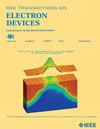Bias-Selectable Dual-Mode SOI/PbSe Heterojunction for Visible-to-Shortwave Infrared Photodetector
IF 2.9
2区 工程技术
Q2 ENGINEERING, ELECTRICAL & ELECTRONIC
引用次数: 0
Abstract
Silicon-integrated broadband photodetectors covering a wide spectral range are important for next-generation optoelectronic systems. Directly building heterojunctions based on the stacking of bulk silicon and narrow-bandgap semiconductor thin films has emerged as an interesting research focus, considering their simple and effective fabrication methods. However, the long diffusion length of the charge carriers limits the response time, and the intrinsic lack of gain of the photodiode results in low infrared response in devices. In this work, we report a bias-selectable broadband and high photography-responsive Si/PbSe heterojunction photodetector fabricated on silicon-on-insulator (SOI) substrate. Specifically, the device operates in photodiode mode under reverse bias with responsivities of 4 mA/W and可见光-短波红外探测器用偏置可选双模SOI/PbSe异质结
覆盖宽光谱范围的硅集成宽带光电探测器对下一代光电系统至关重要。基于块体硅和窄带隙半导体薄膜的叠层直接构建异质结已成为一个有趣的研究热点,因为它们的制造方法简单有效。然而,载流子的长扩散长度限制了响应时间,光电二极管固有的增益不足导致器件的红外响应低。在这项工作中,我们报道了一种在绝缘体上硅(SOI)衬底上制造的偏置可选宽带和高摄影响应的Si/PbSe异质结光电探测器。具体来说,该器件在反向偏置下工作于光电二极管模式,在520 nm和1550 nm的响应度分别为4 mA/W和3~\mu $ A/W。在正向偏压下,器件处于光导体模式,在520 nm和1550 nm处的响应度分别为6 A/W和250 mA/W。此外,该器件在反向和正向偏置下的响应时间分别为450/390 ns和7/ $8~\mu $ s。我们的研究结果可能为未来用于宽带成像和小型化光谱仪的小型化和多功能硅集成红外探测器的发展提供解决方案。
本文章由计算机程序翻译,如有差异,请以英文原文为准。
求助全文
约1分钟内获得全文
求助全文
来源期刊

IEEE Transactions on Electron Devices
工程技术-工程:电子与电气
CiteScore
5.80
自引率
16.10%
发文量
937
审稿时长
3.8 months
期刊介绍:
IEEE Transactions on Electron Devices publishes original and significant contributions relating to the theory, modeling, design, performance and reliability of electron and ion integrated circuit devices and interconnects, involving insulators, metals, organic materials, micro-plasmas, semiconductors, quantum-effect structures, vacuum devices, and emerging materials with applications in bioelectronics, biomedical electronics, computation, communications, displays, microelectromechanics, imaging, micro-actuators, nanoelectronics, optoelectronics, photovoltaics, power ICs and micro-sensors. Tutorial and review papers on these subjects are also published and occasional special issues appear to present a collection of papers which treat particular areas in more depth and breadth.
 求助内容:
求助内容: 应助结果提醒方式:
应助结果提醒方式:


